This article provides an in-depth description of five fundamental posture exercises. These are the cues and tidbits of information that I go over with my clients in person. When implemented properly, they will greatly increase the benefit you get from doing the exercises.
My goal is to provide you with additional details about each of these five exercises that you may not find in any of my previous videos or from other books or resources on the Internet.
The five exercises are:
Please use your good judgement and choose the exercises that are best for your body at this time. If an exercise causes pain or discomfort, discontinue that exercise and refer to the modifications and progressions listed. Let’s get started.
1. Static Back
The Static Back exercise relaxes the muscles of the lower back and opens the thoracic spine.
Purpose:
Static Back places the shoulders in the same plane as the hips and allows the muscles of the low back to release gradually and passively using your own body weight and gravity. Static Back also engages the hip flexors and encourages thoracic extension. In other words, your upper back will begin to open up against the flat surface of the floor.
By simply allowing the head to rest in line with the shoulders and hips, the muscles of the neck and jaw will also begin to release here in Static Back. Static Back will also begin to neutralize rotation in the pelvis and torso. Avoid chewing gum and texting during Static Back.
Instructions:
- Lie on your back with your legs up over a block or chair. Keep your knees and hips at 90 degrees. Place your arms at your sides at either 45 degrees to your body with your palms up or in line with your shoulders with your palms up.
- Take deep full breaths and just relax.
- Stay here until you feel your low back and hips settle evenly into the floor. This may take 5 minutes or even longer.
If you have been in Static Back for ten minutes and your low back and hips are still not even on the floor, try the other exercises included in this article first before returning to Static Back. Sometimes different areas of the body need to be activated or released before the body is ready to ‘let go’ and settle into a neutral position.
Modification:
If you notice that your head does not easily or comfortably come down to the floor, or if your chin is tilted up and back, then place a folded towel under your head to prop your head up. Elevating your head will place your head and neck in a neutral position and allow the neck and thoracic spine to release. You will gradually be able to lower your head all the way to the floor.
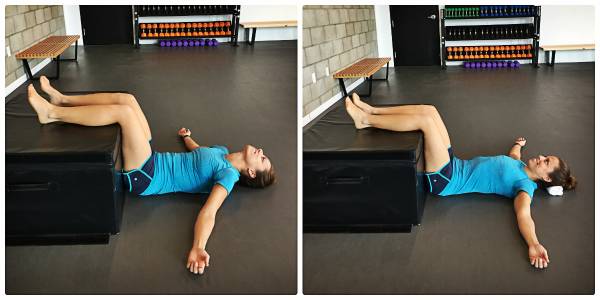
If your neck is in an awkward position (left), place a towel behind your head.
Additional Info:
Keeping your arms somewhere between 45 degrees and shoulder height places the shoulder joints into a neutral position. The scapula should lie flat on the floor, and the shoulders should not be rotated up off the floor. Find the arm position that allows for the most neutral shoulder position. If the shoulders remain rotated off the floor, then stay here in Static Back for 10 minutes and observe as gravity and your own body weight coax your shoulders closer to the floor.
Do not retract your shoulders and actively try to force these changes to happen. Static Back is intended to be a passive release that leads to changes in muscle length and tension and improved skeletal alignment. Having your palms up allows the shoulder joint to open up and settle back towards the floor. If your palms were to be down during Static Back, your shoulder joint would be in an internally rotated position, which is what we are trying to correct here.
If you have an excessively rounded thoracic back and protracted or internally rotated shoulders, you may want to begin Static Back with your palms down as a way to get into positon, and gradually work towards having your palms facing up.
If your knees and feet fall apart while you are in Static Back, you will not get the full benefit of the exercise. To troubleshoot this problem, check your body positioning. This problem is likely to happen if your legs are too low. Try adding a pillow or a folded blanket to the surface that your legs are resting on. Once you relax, your knees and feet can fall apart slightly, but they should remain pretty close to hip-width distance apart.
2. Static Wall
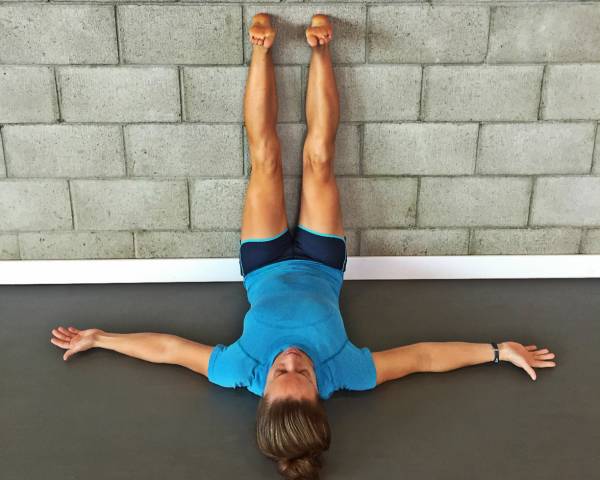
The Static Wall exercise targets thoracic extension and counters the negative effects of sitting all day.
Purpose:
Static Wall promotes thoracic extension. In other words, this exercise encourages your upper back to open up against the flat surface of the floor. This is a more aggressive form of thoracic extension work than Static Back, since the legs are straight and the feet are flexed. This means the entire posterior chain has to lengthen.
This exercise engages the anterior posture muscles of the lower leg (shins and thighs), which typically stop functioning properly when you spend a lot of time sitting. For this reason, it is critical that you keep your thighs tight by contracting your quads and that you keep your feet pulled back, which will contract the muscles of the shin.
Instructions:
- Start by getting on the floor with your hips as close as possible to a wall.
- Place your back on the floor and bring your legs up the wall with your butt as close to the wall as possible.
- Lie on your back with your legs pointed straight up and against the wall, upper body relaxed with arms out to sides at about 45 degrees, and palms facing up. Your feet should be hip-width apart, which is about one and a half fist widths apart. If your hips lift off the floor, then scoot your butt back until you are able to place your hips flat on the floor. As you become more functional, your hips will sit closer to the wall and be flat on the floor at the same time.
- Hold for 2-4 minutes.
In this position, tighten your thighs and pull all of your toes down and back evenly towards your face. Your feet must be pointed straight (parallel) for your hips to properly do the needed work to stabilize your spine. Be sure to keep your toes pulled back and thighs tight.
Modifications:
If your tailbone does not rest flat on the floor when you are in Static Wall, scoot back until your tailbone is flat. If you are so tight that you simply cannot pull your toes back and keep your tailbone flat even after scooting back 6-12 inches, then you will need to do some more spine and pelvic extension work before you return to this exercise. Begin with Static Extension Position and Upper Spinal Floor Twist, which are both explained in my video titled Hamstrings 101: Start By Stretching Your Back. These will encourage extension of the spine and pelvis and subsequent gentle lengthening of the hamstrings.
Additional Info:
The most commonly made mistake in Static Wall is improper foot and ankle positioning. In order to get the full benefit of Static Wall, your feet must be pulled back evenly and must be pointing straight out from the wall. Improper foot and ankle positioning in Static Wall (shown on the left) is characterized by feet that turn out and pinky toes that are higher than the big toes.

Make sure your feet are the correct width, and parallel.
To find the correct foot/ankle position for Static Wall, first get into position on the floor with your legs up the wall. Spread your heels one and a half fist widths apart (any wider than this will be wider than hip-width and thus too wide). Pull your feet back, and pull down from the pinky side of your foot. Keep that outer edge of your foot pulled back. Then internally rotate your legs until your feet point straight back from the wall.
Simply getting into the proper foot/ankle position for Static Wall can be a herculean effort for many, but taking the time to nail this position will make or break this exercise. It is better to perform Static Wall with the correct positioning for a shorter period of time than to do it incorrectly for a longer period of time.
3. Sitting Floor
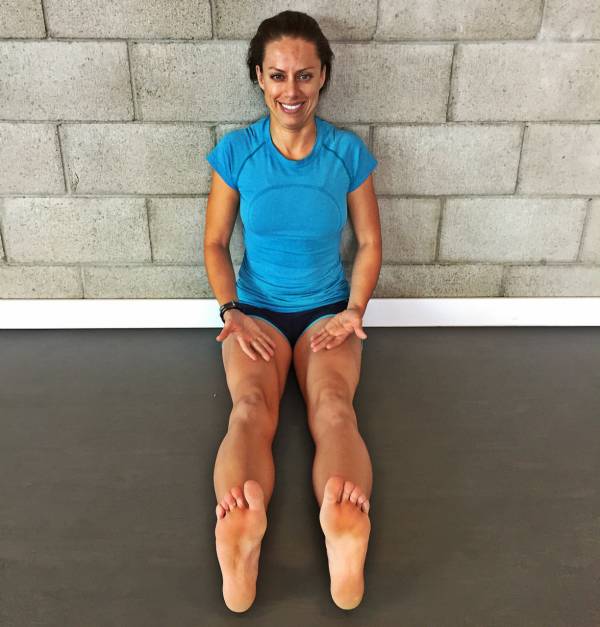
The Sitting Floor exercise helps strengthen the muscles that hold you up straight.
Purpose:
This exercise strengthens the muscles of the upper back and shoulders that hold you upright. It also engages the anterior posture muscles of the legs (shins and thighs) which typically stop functioning properly when you spend a lot of time sitting. For this reason, it is critical that you keep your thighs tight (contract your quads) and feet pulled back (which will contract shin muscles).
For an added challenge, see if you can get your heels to pop off the floor by fully extending the knees and tightening the quads.
Instructions:
- Sit against a wall with your legs straight out in front of you. Your buttocks and upper back should be against the wall the entire time.
- Squeeze your shoulder blades together and down and hold. Tighten the thighs and flex the feet back so that your toes are pointing back toward you. The key points here are to keep your shoulder blades pulled together, your thighs tight, and your feet flexed back.
- Hold for 1 – 3 minutes.
Modification:
If you are not able to sit your hips all the way back to the wall, start with the Static Back and Static Wall exercises included in this article before you progress to Sitting Floor.
Additional Info:
Many people are so internally rotated in the shoulders and rounded forward in the thoracic spine that they cannot get a good scapular retraction here in Sitting Floor without cheating. If you find that you have to lift your sternum and arch your low back excessively in order to pull your shoulder blades together, you are cheating.
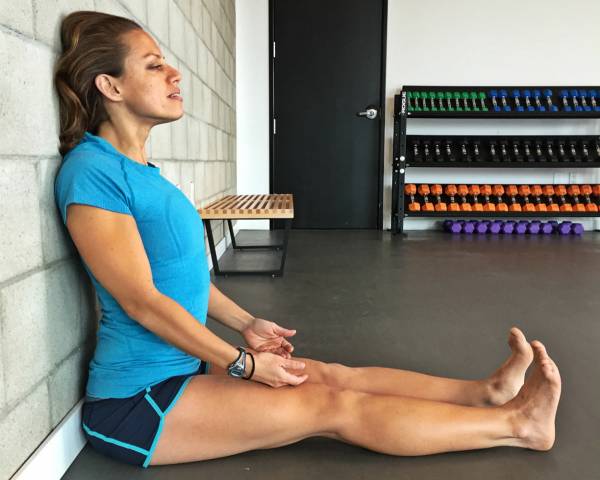
Arching your back to achieve scapular retraction is cheating.
Instead, first drop your sternum and rib cage to place your low back flat against the wall. Then gently pull your shoulder blades down and together, but without lifting your rib cage. It is okay to have a small arch in the lower back, but not at the expense of creating a ‘false’ thoracic extension by lifting the rib cage. Finally, tuck your chin and breathe up into your chest for the duration of the exercise.
Warning: Trying to do a good Sitting Floor is like trying to rub your belly, pat your head, chew gum, walk, and carry on a conversation all at the same time. Have patience with yourself and focus on constantly scanning your body to ensure that you are hitting all the points (feet pulled back, thighs tight, rib cage neutral, shoulders back and down, chin tucked). Don’t forget to breathe!
4. Air Bench
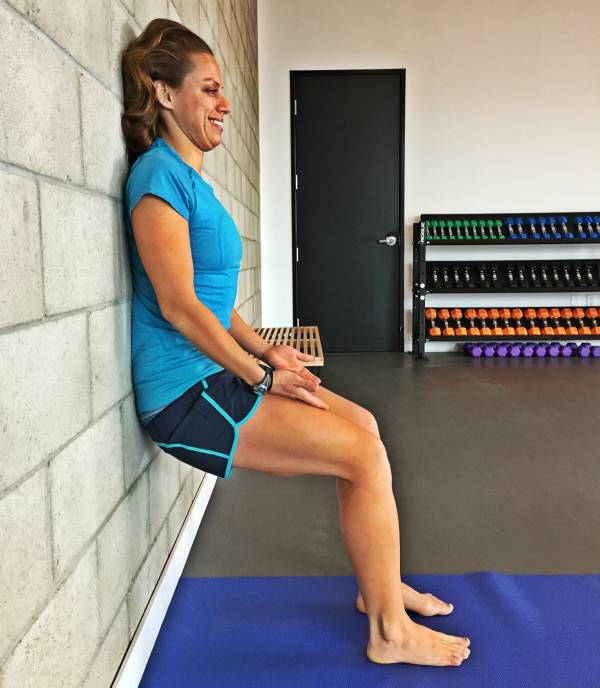
You may have done something similar in grade school, but the right tweaks make the Air Bench a great corrective exercise.
Purpose:
One of the primary purposes of Air Bench is to eliminate or reduce rotation in the pelvis. In order to achieve this result, your feet, knees and hips MUST all be even. Check to see if one knee juts out in front of the other. If so, then that means your pelvis is rotated while you are in Air Bench, which will negate the benefits of the exercise. Push your pelvis back into the wall equally on both sides until your knees are in the same plane, then begin your timer.
Air Bench will also ‘re-set’ your pelvis and low back. For this to happen, your low back must be flat against the wall for the duration of the exercise. This will allow your low back muscles to relax.
Do not worry about keeping your shoulders and head back at first. In fact, feel free to slouch in order to get your low back and hips even against the wall. Once you can maintain this position for 1 minute with your low back flat, then start working on bringing your shoulders and head back to meet the wall while maintaining a flat spine.
There is a lot more to Air Bench than the wall sit exercise from grade school where the goal was to try and hold that position for as long as humanly possible. Air Bench, when done a particular way, can have a huge positive impact on posture and muscle function. Here’s the scoop:
Instructions:
- Stand with your back against a wall with feet and knees hip-width apart and feet pointed straight. You should have one and a half fist widths between your ankles and knees.
- Walk your feet away from the wall while sliding your body down at the same time. You will be “seated” in an invisible chair, with your knees bent to 105 degrees. Your hips should be just slightly higher than your knees; your ankles should be slightly ahead of your knees. Your low back should be completely flat against the wall. Your arms can hang down to your sides, or rest gently on your lap.
- Hold for 30 seconds to start, then work up to 2 minutes.
Keep the weight in your heels, and do not press forward on your toes. In order to avoid slipping, be sure to do this exercise wearing shoes or standing on a non-slip surface, such as a yoga mat.
Modifications:
If Air Bench hurts your knees, try bringing your hips up higher and make sure that your ankles are out in front of your knees. Also make sure that your ankles, knees, and hips are aligned. Once you get into position, you should begin to feel the work happening evenly in both quads. If the knee pain persists, then try Static Back, Static Wall, and Sitting Floor first. Return to Air Bench when you feel you are ready.
Additional Info:
The most common mistake I see with Air Bench is improperly aligned ankles, knees, and hips.
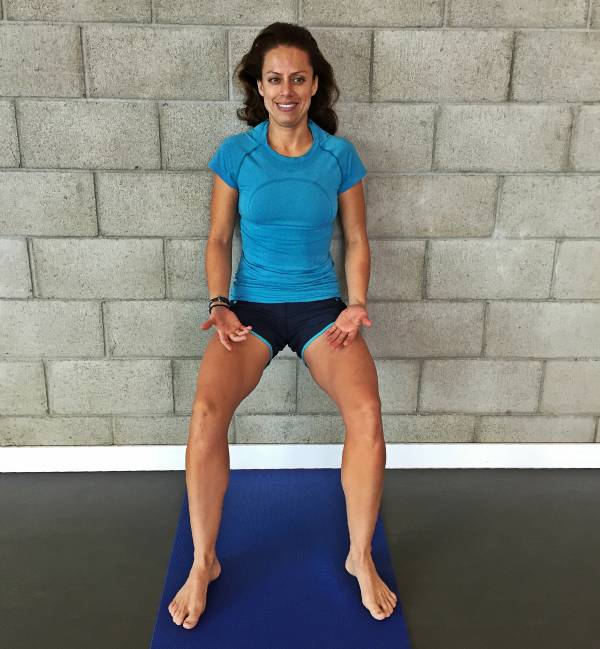
The knees are well outside the hips, rolling the ankles out. Align all 3 joints for correct form.
5. Standing at Wall
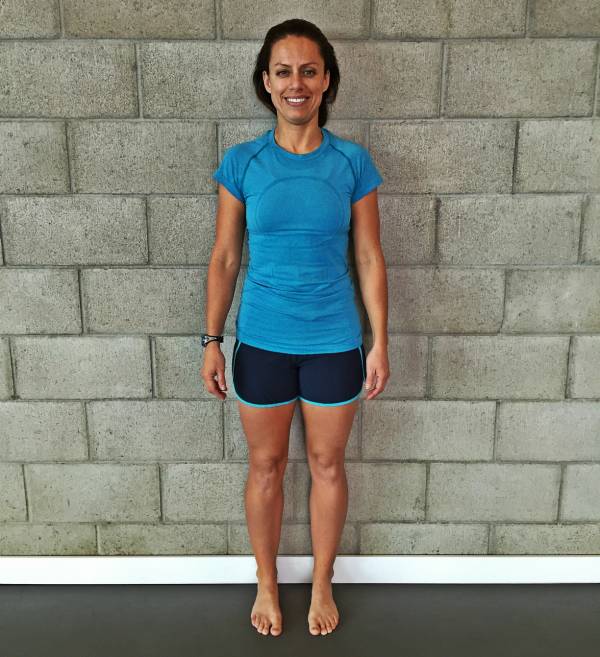
It’s just standing, right? But when you add a wall, it forces an alignment you don’t otherwise achieve.
Purpose:
This exercise promotes proper vertical alignment of the 8 major load bearing joints, the shoulders, hips, knees and ankles. At the same time, posture muscles from the feet all the way up to the neck are getting a workout. Try to wiggle your toes from time to time and make sure that you breathe.
Instructions:
- If possible, do this exercise barefoot. Stand against a wall with your feet pointed straight ahead and hip-width apart. This means you should have a fist and a half width between your heels, and your feet should be slightly turned in.
- Stand with your heels, hips, and shoulders touching the wall. Your head should be in a comfortable position so that your eyes are looking straight ahead to the horizon. In many instances, when people try to put their head against the wall they end up looking up at the ceiling because their neck is under stress. In this exercise your head will go back to the wall eventually as the upper back changes position.
- Relax your stomach and your arms and allow your body to adjust to this new position. Remember to keep your feet pointed straight ahead and your stomach relaxed throughout the exercise.
- Hold for 2-3 minutes.
Modification:
If you are not able to stand with your heels touching the wall, try starting with your heels 2-3 inches away from the wall.
Additional Info:
For an added challenge, bring the backs of your hands to the wall with your fingers spread wide and your arms at 45 degrees to your body for the duration of this exercise. This will work the muscles of your upper back and shoulders.
Now Do It Every Day
I recommend working these exercises into your daily routine. The forces of gravity are constant, and we just don’t move enough in our day-to-day lives to maintain the full functionality of our bodies. If done correctly, these exercises will help to restore proper joint alignment.
More from Maryann’s Banish Pain Series
- Banish Pain Permanently: Correct Your Alignment
- Banish Pain Permanently: 3 Self-Assessment Tools
- Banish Pain Permanently: Where You Think It Is, It Ain’t
- New on Breaking Muscle Today
Teaser photo courtesy of Shutterstock.
All other photos courtesy of Maryann Berry.






